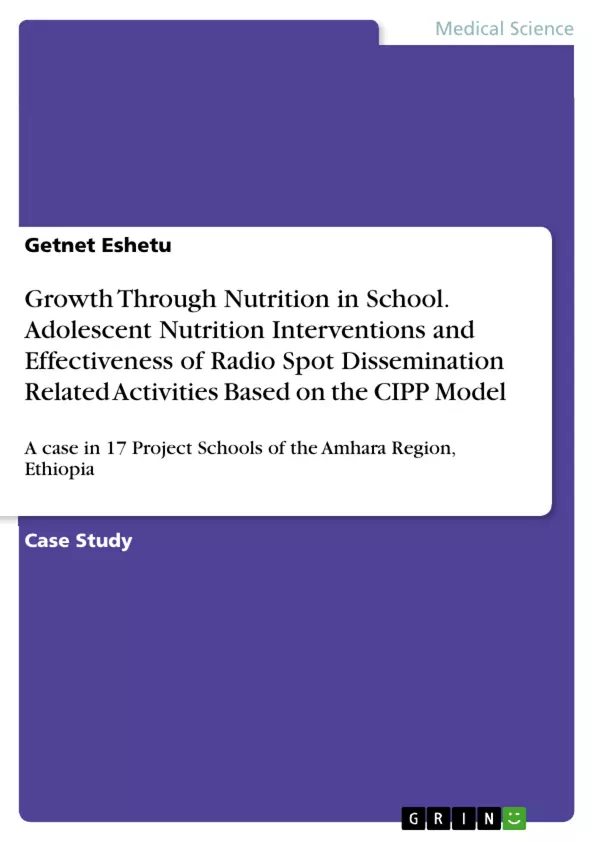Good Nutrition is key to good mental and physical health. Nutrition communication is an art and technique of informing, influencing, and motivating individual, institutional and public audiences about the importance of nutritional issues.
This mixed method research aims to determine the effectiveness of the Nutrition Audio messages communication performance and recommended some ideas for improving it. In this research, 500 nutrition club member students from 17 schools were participated in questionnaire and FGDs; 17 focal teachers,17 principals and 4 media directors answered open ended questions.
Inhaltsverzeichnis (Table of Contents)
- Chapter One
- INTRODUCTION
- 1.1. Introduction.
- 1.2. Background of the study.
- 1.3. Identification of the problem.
- 1.4. Purpose statement
- 1.5. Significance of the study.
- 1.6. Research questions.
- 1.7. Assumptions.
- 1.8. Limitations.
- 1.9. Operational Definitions.
- INTRODUCTION
- Chapter Two:
- LITRATURE REVIEW
- 2.1. Legal considerations
- 2.2. Nutrition communication
- 2.3. School based health and nutrition programs.
- 2.4. School Nutrition Clubs.
- 2.5. Media role for nutrition behavior change
- 2.6. School mini-media roles for behavior change.
- 2.7. Theoretical Backgrounds: CIPP and KAPS Models.
- LITRATURE REVIEW
- Chapter Three:
- METHODOLOGY
- 3.1. Sampling Procedure and Participants
- 3.2. Development and dissemination of audio nutrition messages.
- 3.3. Procedure
- 3.4. Instrumentation
- 3.5. Data Collection and Analysis.
- 3.6. Validity and Reliability.
- 3.7. Ethical Considerations.
- 3.8. Dissemination of the Research Findings.
- METHODOLOGY
- Chapter Four:
- RESULTS and DISCUSSIONS
- 4.1. Results.
- 4.2. Discussion.
- RESULTS and DISCUSSIONS
- Chapter Five:
- CONCLUSIONS and RECOMMENDATIONS
- 5.1. Conclusions.
- 5.2. Recommendations.
- CONCLUSIONS and RECOMMENDATIONS
Zielsetzung und Themenschwerpunkte (Objectives and Key Themes)
This research aims to evaluate the effectiveness of audio nutrition messages disseminated through school mini-media, integrated with other Social and Behavior Change Communication (SBCC) activities, to provide recommendations for improving communication efforts. The research utilizes the Context, Input, Process and Product (CIPP) model combined with Knowledge, Attitude and Practice (KAP's) evaluation components to assess the impacts on student knowledge, attitude, and behavior change.
- The importance of nutrition education in schools and its impact on students and their families.
- The role of media, particularly audio messages through school mini-media, in promoting nutrition behavior change.
- The effectiveness of integrating audio messages with other SBCC activities.
- The evaluation of the research using the CIPP and KAP's models to assess the program's effectiveness.
- Providing recommendations for improving communication strategies based on the research findings.
Zusammenfassung der Kapitel (Chapter Summaries)
Chapter One provides an introduction to the research, defining key terms and exploring the background of the study. It examines the significance of nutrition education in schools and the rationale for utilizing audio messages as a communication tool for behavior change. The chapter also outlines the research problem, purpose, significance, research questions, assumptions, limitations, and operational definitions.
Chapter Two delves into the literature review, exploring various aspects related to nutrition communication and behavior change. This includes legal considerations, the role of media, school-based health and nutrition programs, school nutrition clubs, and theoretical frameworks like the CIPP and KAP's models.
Chapter Three outlines the research methodology, encompassing the sampling procedure, development and dissemination of audio nutrition messages, the procedure, instrumentation, data collection and analysis, validity and reliability, ethical considerations, and dissemination of the research findings.
Chapter Four presents the results of the research and discusses the findings. This chapter will analyze the data collected and provide insights into the effectiveness of the audio messages and the overall communication program.
Schlüsselwörter (Keywords)
The research focuses on nutrition education, behavior change communication (SBCC), audio messages, school mini-media, CIPP model, KAP's evaluation, knowledge, attitude, and behavior change.
- Quote paper
- Getnet Eshetu (Author), 2021, Growth Through Nutrition in School. Adolescent Nutrition Interventions and Effectiveness of Radio Spot Dissemination Related Activities Based on the CIPP Model, Munich, GRIN Verlag, https://www.hausarbeiten.de/document/1159346


